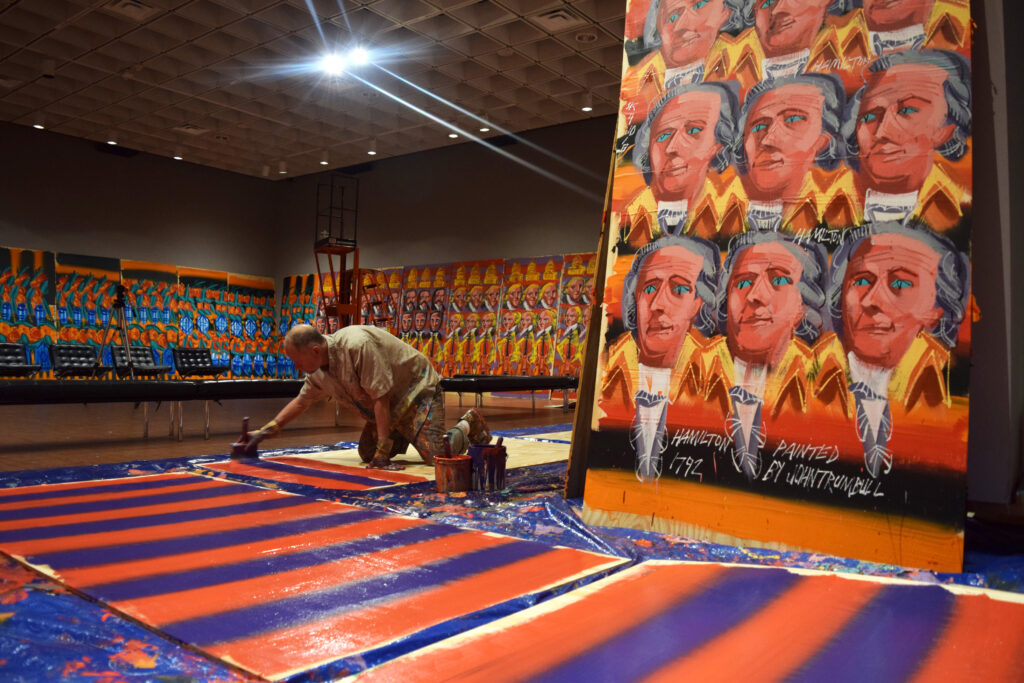
Steve KEENE: RAUSCHENBERG 100 – A Centennial Celebration
August 25 – December 6, 2025
Bob Rauschenberg Gallery ANNEX
8099 College Parkway (Bldg. J/Library-Lobby-Room 118), Fort Myers, Florida 33919
No opening reception, but related events to be announced as scheduled.
Free and Open to the Public.
Gallery Hours: Monday-Saturday 10am-4pm (except holidays)
Florida Southwestern State College is proud to present Steve KEENE: RAUSCHENBERG 100 – A Centennial Celebration – a newly commissioned, site-specific installation of 100 paintings in honor and celebration of the 100th birthday of (our namesake) Robert Rauschenberg at the Bob Rauschenberg Gallery Annex by the “World’s Most Prolific Painter.” Also, dubbed the “Assembly-Line Picasso” by TIME magazine (when his work was featured in 1997) and having created more than 350,000 unique paintings over the last four decades, Steve Keene (born 1957) is a Yale University-educated, Brooklyn-based artist who believes in “mass-producing” hand-painted artworks for the masses.
Like his exhibition “The Miracle Half-Mile” at the Santa Monica Museum of Art in 2000 (where Keene completed more than 10,000 pictures over the two-month run of the show), the internationally-acclaimed painter worked on-site at the Bob Rauschenberg Gallery for two-weeks in 2018 to create his monumental 62-panel (8 x 248 ft. long) The 57 Miles or 455 Furlong Piece – taking inspiration from Rauschenberg’s self-contained retrospective The ¼ Mile or 2 Furlong Piece (which was world-premiered in three-sections at the Bob Rauschenberg Gallery from 1983-86).
Famous among indie-rock fans for designing album covers for bands including Pavement and The Apples in Stereo, Steve Keene has painted instruments, video and concert stage sets, as well as promotional and tour posters for the likes of Soul Coughing, Merzbow, The Klezmatics and the Dave Matthews Band, and has had his paintings collected by REM’s Michael Stipe, DEVO and Cat Power. In addition to features on National Public Radio and in the pages of The Wall Street Journal, New York Times, Los Angeles Times, LA Weekly, Filter and Spin Magazines, the artist has had major solo exhibitions at Moore College of Art in Philadelphia, Rice University in Houston, the Museum Ludwig in Cologne, Germany, the Linden Centre for Contemporary Art in Melbourne, Australia, and the Czech Centre in London.
Sourcing countless “found” photographs/images of Rauschenberg himself, his seminal/iconic artworks (including “Monogram”, “Buffalo II” and others) and his Captiva Island studio/compound, Steve Keene has created this centenary celebration as an ambitious and immersive exhibition of 100 newly-created paintings that capture both the Art and Life of our Bob Rauschenberg Gallery namesake in advance (and during) his October 22nd, 2025 100th birthday.
Additional announcements will follow in coming weeks and months as lectures, performances and special events are confirmed in conjunction with the exhibition.
Bob Rauschenberg Gallery at FSW
The Bob Rauschenberg Gallery was founded as The Gallery of Fine Art in 1979 on the Lee County campus of Florida Southwestern State College/FSW (then Edison Community College). On June 4th 2004 the Gallery of Fine Art was renamed the Bob Rauschenberg Gallery, to honor and commemorate our longtime association and friendship with the artist. Over more than three decades until his death, the Gallery worked closely with Rauschenberg to present world premiere exhibitions including multiple installations of the ¼ Mile or Two Furlong Piece. The artist insisted on naming the space the Bob Rauschenberg Gallery (versus the “Robert Rauschenberg Gallery”) as it was consistent with the intimate, informal relationship he maintained with both our local Southwest Florida community and FSW.
For additional information please call: 239-489-9313 or visit us on Facebook or Instagram
WGCU – Brooklyn-based artist Steve Keene – August 8, 2025
Florida Weekly What To Do – Steve KEENE Rauschenberg 100 – August 20, 2025
Photos Courtesy of Brian Teitz










